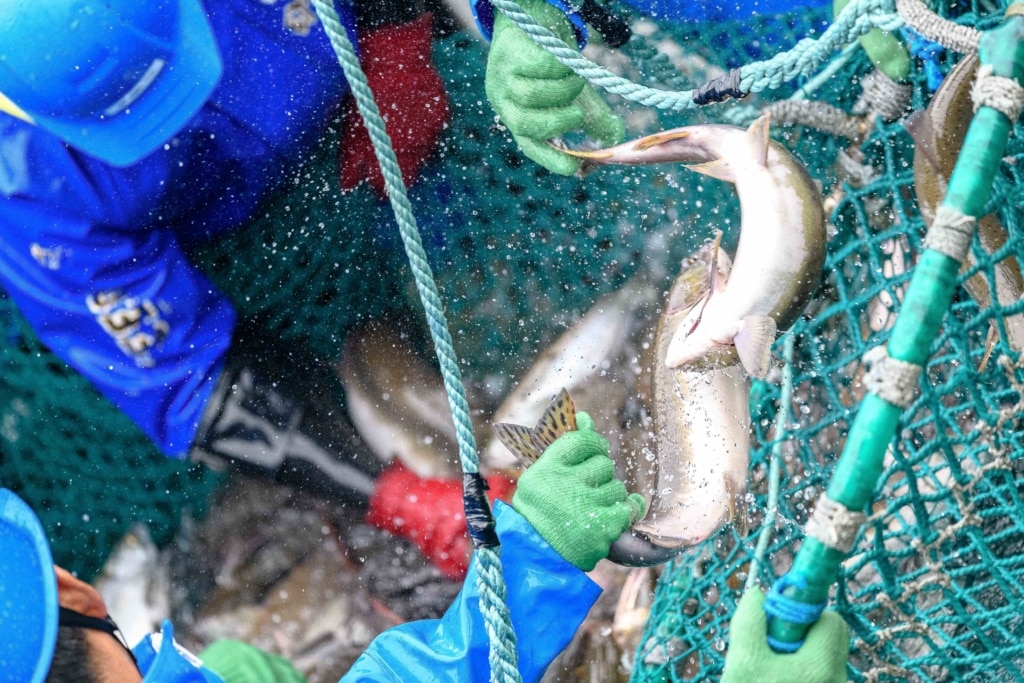
Reflecting on the Significance of Japan’s Revised Fisheries Act One Year After its Implementation
Hello, everyone. This is Wakao Hanaoka, CEO of Seafood Legacy.
December 1st, 2021, marks the end of the first year after the revised Fisheries Act came into effect.
Surging demand for sustainable seafood around the world
The UN Food Systems Summit was held in September this year, which was followed by the 15th Conference of the Parties to the Convention on Biological Diversity (COP15) and the 26th Conference of the Parties to the United Nations Framework Convention on Climate Change (COP26) that were held in succession in October. The policy of “green recovery,” which combines economic recovery measures with policies aimed at addressing climate change and the conservation of ecosystems, is likely to gain further traction in maritime sectors around the world. In the financial sector, the movement of transforming global capital flow to create a positive impact on the natural environment (or “nature-positive”) is gaining momentum, too, and while the fisheries sector has also been identified as one of the three most important areas that need to be addressed.
The world population is 7.875 billion in 2021 and is expected to reach 8.5 billion by 2030, 9.7 billion by 2050, and 10.9 billion by 2100. Given the difficulties involved in significantly expanding land-based production to meet the rising demand for food that accompanies the growing population, it has become vital to improve the productivity of the fisheries and aquaculture industries, or in other words, how we derive food from the ocean, which accounts for 70% of the earth’s total surface area. Seafood Legacy believes that as a country surrounded by waters housing a vibrant marine ecosystem that count among one of the world’s three largest fishing areas and a country where several major international seafood companies that have a major impact on the global seafood industry are located, Japan possesses massive potential in terms of its ability to take on this urgent global challenge.
Transforming Japan’s fisheries industry into a growth industry
There was a time when Japan’s fisheries industry had boasted the largest catch in the entire world. However, the overfishing of juvenile fish and species whose populations are declining has led to a degradation of fishery resources, with catches falling to less than a third of what they used to be at their peak and the number of fishermen shrinking to fewer than a quarter of what it had been. While the World Trade Organization (WTO) is debating the abolition of subsidies that encourage overfishing and the proliferation of IUU (illegal, unregulated, and unreported) fisheries in pursuit of SDGs 14.6, Japan’s fisheries industry remains in a position where it is unable to survive in the absence of major subsidies. As a result, it has been pointed out that the business model of Japan’s fisheries is on the verge of collapse, with more and more people (especially in the world of ESG investment and financing, which has become increasingly active in recent years) perceiving the fisheries industry as a high-risk sector. Based on the projections made by the Food and Agriculture Organization of the United Nations (FAO) on the future fisheries production of major fishing nations, Japan is expected to experience the greatest decline moving forward, despite the fact that almost all developed and developing countries will likely increase their production.
Under these circumstances, the revised Fisheries Act could play a major role in allowing Japan’s fisheries industry to break away from its current decaying business model through the robust implementation of the measures under this law. In his keynote speech at TSSS 2021, Takashi Koya (Director-General of the Fisheries Agency) explained the vision, details, and background of the revised Fisheries Act, which comes across as a powerful, future-oriented law that has been centering on the aim of tackling the fundamental issues. Seafood Legacy sees the revised Fisheries Act as marking the beginning of a sustainable growth industry that seeks to restore the fishery resources in the waters of Japan through resource management based on scientific evidence and precautionary principles, and which utilizes these resources in a systematic, strategic, and productive manner from a holistic perspective.
Roadmap for transitioning to a new form of resource management
The implementation of the revised Fisheries Law has been guided by the Fisheries Agency’s goal of restoring Japan’s catch to its level 10 years ago (a target of 4.44 million tons) by 2030, the target year for achieving the SDGs, by transitioning to a new form of resource management. In order to achieve this goal, the agency has announced a “Roadmap for transitioning to a new form of resource management”, which sets out to achieve several numerical targets by FY2023, including the following.
<Key points in the roadmap for a new form of resource management>
Enhancement and improvement of the accuracy of resource surveys and stock assessments: The target species of stock assessments have been expanded to 200 different species, MSY-based stock assessments will be conducted, and target/limit reference points have been set.
Establishment of an electronic reporting system: Electronic reporting has been implemented for fisheries licensed by the Minister, which will be gradually expanded to include fisheries licensed by Governors. In addition, a system for gathering landing-related information in production areas from over 400 major fisheries cooperatives and on-site markets will be established.
Improvement of resource management: IQ management will be introduced to fisheries licensed by the Minister that mainly target TAC species, with 80% of all catch subject to TAC management. The remaining 20% of catch that is not subject to TAC management will be fully transitioned from resource management plans to resource management agreements. (*Resource management agreements refer to agreements that involve fishermen preparing and implementing stock recovery plans, whose effectiveness will be assessed by the Fisheries Agency and whose details and assessment results will be published.)
(Excerpted from the “Roadmap for transitioning to a new form of resource management” published by the Fisheries Agency)
Optimism for a brighter future for Japan’s fisheries industry has grown with the setting of these long-term goals and a clear commitment to numerical targets and timelines for achieving these targets, which have since been created and published. I hope that more stakeholders can share this vision of a brighter future that lies ahead with the achievement of these targets and that this roadmap can be successfully implemented in a collaborative manner.
Implementing the roadmap
In practice, however, many issues need to be resolved before the roadmap can be successfully implemented. Although the roadmap’s implementation is already underway, the proposed FY2022 Fisheries Budget is extremely short-sighted and weighted too heavily towards preserving the income of fishermen through subsidies in the immediate future. Unfortunately, this means that the message of transitioning the fisheries industry to a sustainable growth industry by strengthening resource management has receded into the background. I understand how difficult the current circumstances are for fishermen, but we must keep in mind the fact that if we only focus on kicking the can down the road until the root cause of the issue is resolved, the decline of fisheries resources will accelerate, and the effort and cost required for their recovery will ultimately become even greater.
About the “enhancement and improvement of the accuracy of resource surveys and stock assessments”: It is imperative to gain a more detailed understanding of not only the circumstances of the fisheries at sea but also the state of our fishery resources and their underwater habitats if we want to carry out the appropriate resource management to protect the sustainability of these resources. In addition, one of the challenges we currently face is that we have not managed to create the motivation required for multi-stakeholders to engage in resource management. To make progress on both of these fronts, it is necessary for us to ameliorate a structure where the experience-based intuition of fishermen comes up against the data presented by scientists, and to build a system in which these two elements complement each other based on a relationship of mutual trust.
About the “establishment of an electronic reporting system”: By cutting the time required to cycle through the process of information collection→stock assessment→resource management, the state of fishery resources that have recovered through enhanced resource management can be taken into account in real time more efficiently in the course of fisheries management. The establishment of an electronic reporting system is an urgent task as it can eliminate cases where fisheries management based on outdated data does not allow for greater catch despite the species having already recovered in the ocean. Such a system will also reduce the burden that stakeholders place on information reporting and the risks associated with omissions and false reporting.
About the “improvement of resource management”: The expansion of target TAC species and the introduction of IQ will greatly benefit stakeholders and are plans that should be expedited, starting with the species with the greatest catch. Resource management plans for non-TAC species have hitherto been subsidized without any assessment of their effectiveness or the publication of their details (of the nearly 2,000 plans reviewed in 2018, only 37% showed a rise in stock population, while 26% showed a decline), so I believe that transitioning these plans to resource management agreements whose effectiveness will be assessed and whose details and assessment results will be published is a step in the right direction.
In addition, the government’s Basic Fisheries Plan, which is reviewed approximately once every five years, will be reviewed again in 2022. I hope that the powerful, future-oriented vision of the revised Fisheries Act and the roadmap will also be embraced in the revised Basic Fisheries Plan.
Needless to say, the revised Fisheries Act itself has many potential areas of improvement. This was the first major revision to this law in 70 years, and revisions will be necessary every few years moving forward. In line with our “Seafood Legacy 2030 Japan Vision” that we have announced, Seafood Legacy espouses supports the future vision for Japan’s fisheries industry envisioned by the revised Fisheries Act, and we will continue to engage in projects and activities aimed at promoting sustainable and responsible seafood with the goal of achieving this vision.





